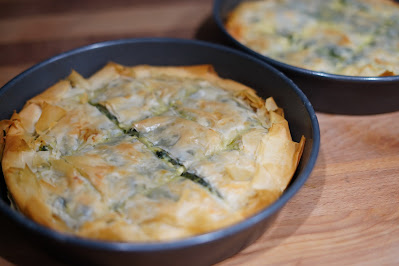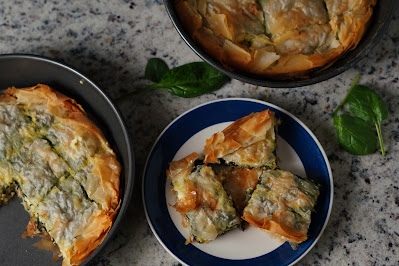I just got back from my first trip to Greece. Oh, what a lovely place. I have full intentions of writing a lengthy post about my experience. In the mean time, though, I had to get in the kitchen!
While on my trip, I did a cooking class. One of the items on the list was spanakopita. At first, I thought, "I already know that one," but was interested in a new method nonetheless. What happened next made me remember the telephone effect; the story that changes each time it is retold.
Spanakopita certainly isn't new to the blog. I've shared it twice; once early on, and once when my kitchen was redone. My family's version came from a Greek cookbook purchased at a Greekfest (so, at the Greek Orthodox Church), and has evolved slightly over time. And there are many ways to make spanakopita (though, the mini triangles I grew up with are called spanakopitakia, instead). My family version involved at it's core spinach, feta, cottage cheese, phyllo, and butter. And I should note that I remember a cooking show with a Greek host featuring Greek Yogurt over cottage cheese, and I've seen it with ricotta and cream cheese as well.
When I went to the class in Mykonos (through Mykonian Spiti and Farm), though, I was told that there are some variances regionally (which is no surprise, given that Greece is rather spread out and there are varieties from other countries as well), but that for sure, 100%, butter is not the ingredient of choice to brush on the phyllo. Olive oil is the priority. This was one of the most shocking things to me, being how religiously we melted butter on the stove before using it to cook. This is one of the biggest things I remember as a kid; one stick of butter, one roll of phyllo. Take a break, melt another stick, unroll the second roll.
Secondarily, I was told no to cottage cheese. Only feta. Now, when I returned home, I did some research and learned about kefalotyri, which is a ricotta-esque Greek cheese sometimes mixed in. Clearly I've got some taste testing to do, but I think the cheese variances are acceptable.
This post is intended to be as much like the class as I could recreate so that my family could try it (and because it really was good and I needed it in my life again). What did I do different? I used a little less olive oil in the pot (okay, a lot less - they had a solid layer, and I just struggle to live with myself when I imagine that much of even a good oil in my food) and leeks.
The recipe I brought back isn't exactly what we made in the class, but I used one 0.75 ounce package from the grocery and it looked right. It's no small quantity of seasoning.
The leeks we used quite a bit of. I thought I could get by with 1 leek, but between peeling and slicing, I realized I had about 25% of what we used in the class. But I should note, leeks are also expensive, so I did not mind cutting back to make a realistic recipe. I paid $2 for one! Not photographed here are the green onions, of which I used about 1/4 cup.
I heated olive oil in a large stockpot (or in my case, dutch oven) and sautéed the leeks, onions, and dill for a few minutes. I then added the spinach to the pot and covered it. The recommendation in class was to put the spinach in and leave it, but I stirred it a bit anyway to evenly cook it.
It always amazes me how much spinach cooks down, and sure enough, I had a good smashed down amount at the end. I spooned the spinach to the side of the pan to keep it as much out of the hot water as I could while it cooled.
On to the crazy part for me. Time to make spanakopita in one pan! The phyllo I use is thinner than what we used in the class; apparently, we Americans sell dessert-style phyllo and usually spanakopita requires a thicker version. There aren't a lot of options, so the best solution is to double up. Another pro tip: let it thaw on the counter vs the fridge when purchased frozen.
I brushed olive oil in the pan first, then put 2 sheets of phyllo in and brushed more. The sheet is larger than the pan, and that's fine; I let it hang over the edges.
I repeated this process twice more and then stopped; it was the mid-way point and time for filling.
The filling consisted of the [slightly cooled] spinach, feta, and 2 eggs. The eggs help hold it all together. I mixed it together in a bowl and scooped in into my pan. In my case, I split this into 2 cake dishes, but you can choose to do one larger one if preferred. It will mean a little extra phyllo.
I repeated the phyllo layers until I used up my sheets. I will say one had a slightly thinner top than the other. That's the balance of using more than one pan.
Next, I cut the excess phyllo off.
Lastly, I rolled the remaining edges in and brushed it with olive oil.
To prevent shattering the baked phyllo (trust me, don't cut it after cooking), I pre-sliced it. The last step was to splash a little water on top. Apparently, this helps make the dough extra crispy.
I let it bake for 30 minutes, until I had a lovely golden pie o' spinach.
Isn't it beautiful?
So, it tasted great. I think of the phrase "savory pie" and it does not appeal to me. But this is the right kind of dinner pie. And dinner pies should be a thing.
There flavor is certainly different than the version I made growing up; I'd say the cheese is a different texture. That's probably the best way to describe it. Not because it was less cheese, but because of the type of cheese; cottage cheese is creamier when cooked. I like the flavor the dill adds; this is something I usually put in my tiropita (the cheese only version of this), and the leeks are a nice touch. I have to admit, I was pretty impressed.
Going to Greece taught me many things. I learned about food and culture and really, in terms of this dish, I learned not to get hooked on what you learned at one point because there is always a different and potentially better way to do things. Recipes become your own as you change the ingredients to meet your tastes. What I used to do and what I did here are not the "right" way to do it, but they are one way. And that's why I love cooking.
I'm so glad I took this class, and hope anyone who sees this feels inspired to give spanakopita a try (unless you don't like spinach. If you don't like spinach, you're out of luck on this dish).
Spanakopita Recipe
Ingredients:
1/4 cup fresh dill, stems removed (or more, up to 2 cups)
Ingredients:
1/4 cup fresh dill, stems removed (or more, up to 2 cups)
1/4 cup chopped leek (or more, up to 2 cups)
1/4 cup chopped green onion
2 bags of spinach (8 ounces each)
3 containers crumbled feta (6 ounces each - about 3 cups)
3 containers crumbled feta (6 ounces each - about 3 cups)
2 eggs
1 roll phyllo (8 ounces) - 1/2 of a standard box
Approximately 1/2 cup olive oil (for brushing)
2 teaspoons salt
1 teaspoon pepper
Instructions:
Add 2-3 tablespoons of olive oil to a large stockpot. Heat to medium and add dill, leek, and onion to the pan. Cook for 3-5 minutes. Add spinach and cook for about 5-7 minutes, until spinach has cooked down. In a medium bowl, mix feta cheese and eggs. Stir in spinach. Preheat oven to 360 degrees F. Using a 9" round pan, brush olive oil in the bottom and around sides. add phyllo dough (1 sheet if thick, 2 if thin). Brush with olive oil. Repeat twice, skipping the olive oil on the top layer. Add filling. Add phyllo again and repeat twice more. Trim excess phyllo from edges. Roll top layer in so it sits on top of pie. Brush with olive oil to prevent burning. Slice pie into pieces. Dip your hand in a small amount of water and gently splash the top of the pie. Place in oven and bake for 30 minutes. Remove and serve. Store in fridge.

















No comments:
Post a Comment